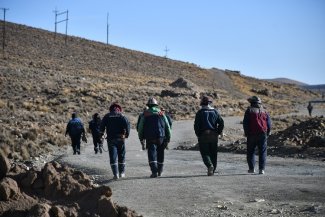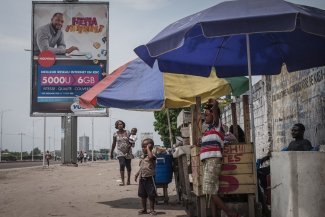After two days and one night, Kylie and Phillip Smith decided which of their milk cows would be sent to the abattoir. As they confess their decision, they avoid looking out of the window at the animals grazing in their field in Ardmona, near Shepparton in south-eastern Australia.
This region of the state of Victoria is one of Australia’s breadbaskets, providing about one quarter of the country’s agricultural produce; not only milk but also cereal, vegetables and fruit.
After South Australia and New South Wales, it was Victoria’s turn to be struck by drought, beginning in 2012 and becoming particularly severe between 2014 and the first half of 2016, causing farmers heavy losses of income.
Because of the drought, the Smiths had to buy more water for their livestock, delivered by tanker.
“It has cost AU$90,000 (approximately US$68,600) this year. We are not paying our electricity bills. We are also in negotiation with our bank and grain suppliers, to ask for their patience. It’s hard. We still have hope, [which is a] farmer’s richest resource.”
Earnings from the sale of 30 cows – out of a herd of 150 – allowed them to free up AU$12,000 (about US$9,200) which will cover the cost of just one month’s supply of animal feed.
As if the climatic conditions were not enough, the fall in the price of milk in Australia to below the cost of production has brought producers to their knees.
On 1 July the price of milk fell from 44 to 36 cents a litre. But farmers need at least 60 cents a litre to make production viable.
“We lost AU$60,000 (US$45,000) of our annual income overnight,” sighs Kylie, as she bottle feeds her four-month-old son Jacob. The family will now have to rely on food parcels.
As a fourth-generation farmer, Philip has already experienced hard times caused by the climate and market prices but this time, he says, “is worse than anything my family has ever experienced.”
Government aid ineffective
During its electoral campaign in May 2016, the right-wing coalition, to which Prime Minister Malcolm Turnbull belongs, promised a fund of half a million Australian dollars (US$385 million) in the form of loans at a favourable rate of 2.66 per cent to help producers.
After winning the election in July, the government made this fund available, but with little success.
“The criteria for granting a loan are unclear, and the administrative steps are off-putting. They want to discourage us,” says Alex Robertson, a farmer who with a few of his friends set up the Facebook page Farmer Power.
Barnaby Joyce, the Agriculture Minister, has not disclosed the figures for the number of loan applications registered, or the farms that have benefited from this assistance. He has announced a symposium at the end of August in Melbourne with partners “to discuss solutions,” explains Kate Barwick, the Minister’s spokesperson.
With exactly 4127 out of a total of 6128, Victoria has by far the highest number of dairy farmers of any state in Australia.
“The number of producers has fallen from 14,000 in 2000 to 6,128 today and half of them have small farms of about 200 cows,” says Bill Malcolm, an agricultural economist and professor at the University of Melbourne.
He doesn’t believe that a loan fund for small farmers will be effective either.
“Our competitiveness on the export market is being tested by the stocks made available on the international market produced by the emerging economies. The crisis we are talking about today is the result of the disastrous management of the dairy companies. They failed to adapt to the needs of the international markets by adjusting their prices early enough.”
Yet dairy farming is one of the leading sectors of Australia’s agricultural industry. It ranks third behind wheat and beef production, with an annual output of 9.7 billion litres, and is worth AU$13 billion (US$10 billion).
With an increasing population, domestic consumption of dairy products has risen slightly. However 30 per cent is still exported, according to Dairy Australia, an organisation co-financed by the government and the producers.
The companies that buy and process the milk use this figure to justify the fall in price, which they say is linked to the difficult foreign sales scenario and the price of milk on the international market.
The producers challenge this view, saying that exports and dependence on the international market are not so important. Domestic consumption of flavoured milk, for example, was not taken into account in the calculations, they say.
The government has let it be known that it will not intervene. Richard Meredith, a spokesperson for Dairy Australia, defends their position: “It’s the free market. We are not a charitable organisation. We provide management advice and we make the results of research available, that’s all.”
But for farmers’ advocates, this kind of response isn’t good enough. “Dairy Australia would not exist without the farmers but it is doing nothing to help them,” says Brian Egan, the founder of Aussie Helpers.
This charitable association has responded to the desperate situation by providing the Smith family and others with emergency supplies: animal feed, food parcels and a little money. “We are the only ones to provide any support and we are solely reliant on private donations and volunteers.”
The former farmer gives his own analysis of the situation: “I don’t think there was an overproduction of milk. It is just that the big cooperatives were over ambitious and they made promises,” says Egan.
“Now the farmers are faced with the debts they contracted with these dairy companies who asked them to bear the cost of the fall in the price per litre retroactively. Many of them have their hands tied and are in no position to protest.
But the Australian farmer’s biggest enemy is his/her own pride. He/she is not very good at defending his/her own rights.”








